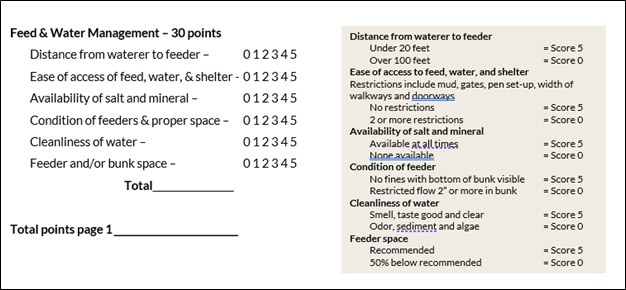Feedlot Evaluation: How Does your Feedlot Rate?
Posted: June 1, 2021

Anyone feeding cattle right now is feeling the tight margins due to input costs rising and market prices not following. Whether we should place cattle in the near term is a tough call. What is not a tough call is that if we are tending to cattle today, we need to increase our management skills to be sure we achieve higher performance and efficiency.
One way to start is to conduct a feedlot evaluation. Evaluating your feedlot can uncover situations that are reducing profitability. Critical self-evaluation is essential. We often become “Barn Blind” and overlook what some people might notice right away.
Look closely at all aspects of your operation. Even small changes in your management practices can make a difference to your bottom line. Several key management practices include steer comfort, implants, vaccination and water. These all can affect performance and profitability in large ways.
Form-A-Feed has a thorough evaluation worksheet available for you to use. It is simple yet informative. The evaluation is based on 100 point score. Key areas covered are animals, facilities, pens, water, and facilities. There is also a clarification guide for each category that explains how to assign a point value. Each category has a numerical ranking that you choose based on a description of the category. For example, if the feeder and water are 20 ft or less from one another you would score a 5. If they are 100+ ft apart the score would be 0.

That means if the water and feed can be closer you will see more opportunity for daily gain increases because the cattle will be able to get to the 2 most important elements of their performance, feed and water, with less effort.
When you have completed the evaluation worksheet and tallied your score, you can use this information to guide your management decisions and look for areas to improve upon. Below are several key strategies that can help improve cattle performance and efficiency:
- Improve steer comfort by keeping the animals clean, out of severe weather conditions, and having easy access to feed and water. This includes providing windbreaks, shade, and misters when needed. If there are fans be sure to clean the dust off of them annually and check the condition of the wiring.
- Walk through pens or lots on a daily basis to monitor all cattle for injury or the start of illness. Make sure that all steers get up and move around the lot.
- Keep feed bunk or self-feeders clean and free of fines. Also be sure to control waste. Adjust feeder openings properly to avoid waste and repair any holes or gaps in the feeder or bunk floor. A 3% waste can equal up to $20.00 per head. Be sure the corn:pellet ratio is correct for the weights of the animals in the pens.
- Re-evaluate your implant program to avoid gaps in between implants. If your current implant runs out at 1300 pounds and you are feeding steers to 1500 pounds, you will see a marked reduction in gains and feed efficiency.
- A solid and thorough vaccination program helps to reduce disease incidence and keep cattle healthy. A Texas A & M study found that cattle on a thorough vaccination program resulted in $117 greater profit per head due to decreased medicine costs, better feed efficiency, and improved performance. One big vaccination that is over-looked is Clostridal (7-Way) with many times a proper booster not being administered. The results can be bloating, reduced feed efficiency, or worse, sudden deaths. Death loss is exactly that – a loss – something that will never be regained. The timing of vaccines is critical. Be sure to discuss a program with your veterinarian.
- Water is a key element to feeding cattle. Location of water can be overlooked. The water source should be located close to the feed source to encourage consumption. If it is inconvenient for steers to walk across the lot to get a drink then back across the lot to eat again, they may eat & drink less. Also having multiple water sources has been shown to encourage feed intake and help spread out the cattle during heat events to keep them cooler. Cattle splashing water and or rapid tail switching may be a sign of stray voltage.
- Keep cattle supplies current. Market cattle when they will grade choice. Feeding them out to heavier weights does not necessarily translate into more profit.
- Dump poor performers. Some cattle may never reach their full potential due to injury or illness, and you may be money ahead by marketing them now rather than continuing to pour feed and money into them.
- Feed a well-researched product that contains yeast, sodium diacetate, and proper mineral levels. These components will aid digestion and improve your feed efficiency.
- Bed properly when needed. Mud and manure tag has a negative effect on dressing % and live cattle buyers do make an adjustment when they are bidding.
- Keep the weight your cattle have gained. Follow the suggested guidelines to help reduce transportation shrink. Use Hydro-Lac prior to shipping.
Our goal is to help you find what may be holding back performance or decreasing efficiency of your feed and or your time. If you would like to receive a copy of the feedlot evaluation worksheet, please fill out the form below:
Feedlot Evaluation Worksheet Request
If you would like a Form-A-Feed representative to help you with the results of your evaluation, please contact us at this link: Contact Us